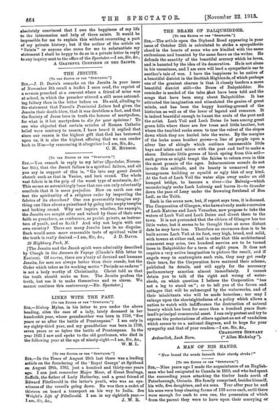THE BRAES OF BALQUHIDDER.
[To TIM EDITOR OP TEE "SPECTATOR.")
Sru,—The article upon the Styhead Road appearing in your issue of October 25th is calculated to strike a sympathetic chord in the hearts of some who are kindled with the same enthusiasm and haunted by the same fears as the writer. He defends the sanctity of the beautiful scenery which he loves, and is haunted by the idea of its desecration. He is not alone in his uneasiness, and I am sure will lend a sympathetic ear to another's tale of woe. I have the happiness to be native of a beautiful district in the Scottish Highlands, of which perhaps one of the greatest charms is that it closely borders a more beautiful district still—the Braes of Balquhidder. No reminder is needed of the tales Abet have been told and the songs that have been sung about Balquhidder. It has attracted the imagination and stimulated the genius of great minds, and has been the happy hunting-ground of the historian as well as of the lover of legend and romance. It is indeed beautiful enough to haunt the souls of the poet and the artist. Loch Voil and Loch Doine lie here among great green hills where there are few trees and little heather, but where the tumbled rocks seem to tear the velvet of the slopes down which they are hurled into the water. By the margins of the lochs some heather grows—a line of purple upon a, silver line of shingle which outlines innumerable little bays and inlets and mixes with the peat and turf to make a shore. Delicate little groves of birch spring from this soil— such groves as might tempt the fairies to return even in this the most prosaic of the ages. Inharmonious sounds do not invade this solitude, and its beauty is unmarred by one incongruous building or squalid or ugly blot of any kind. At the foot of Loch Voil the water slips away under an old humped bridge, to become a river—the Balvaig—which meanderingly seeks Loch Lubnaig and leaves it—to thunder down the pass of Leny under the frowning forehead of Ben Ledi, as the Teith.
Such is the scene now, but, if report says true, it is doomed. The Corporation of Glasgow, who have already made reservoirs of Loch Katrine and Loch Venacher, now propose to take the waters of Loch Voil and Loch Doine and divert them to the town, it is not pretended that the citizen of Glasgow has too little water, but it seems to be thought that at some distant date be may have less. Therefore an enormous dam is to be built across Loch Voil at its foot, very high, broad, and solid, with towers at either end, and in order that this architectural ornament may arise, two hundred navvies are to be turned loose in Balquhidder for a term of eight years. It does not require a very active imagination to picture the result, and if angels weep to contemplate such ruin, they may get ready their tears, for the Corporation have matured their scheme, published its details, and will apply for the necessary parliamentary sanction almost immediately. I cannot detain you to talk of the right and wrong of water- sheds, on which question I believe the Corporation "has not a leg to stand on"; or to tell you of the farms and cottages that will be submerged by the waterworks, and of their inhabitants who will be made homeless; nor may I enlarge upon the shortsightedness of a policy which allows a nation to watch with indifference the destruction of natural beauty which has been for more than a hundred years Scot- land's principal commercial asset. I can only protest and try to express the protestations of others against an act of vandalism which seems to us a national disgrace, and to hope for your sympathy and that of your readers.—I am, Sir, &a., CHARLOTTE STEWA_RT


















































 Previous page
Previous page